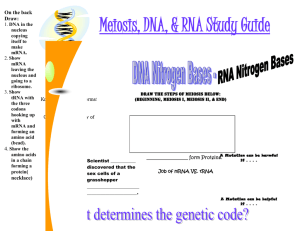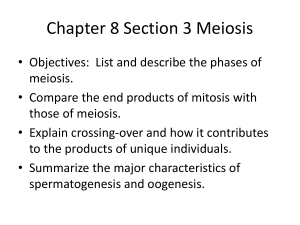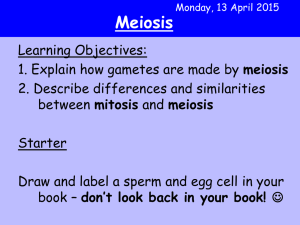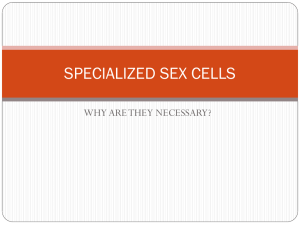The Virtual Biology Labs - Mrs. McKenzie`s Biology Blog
advertisement
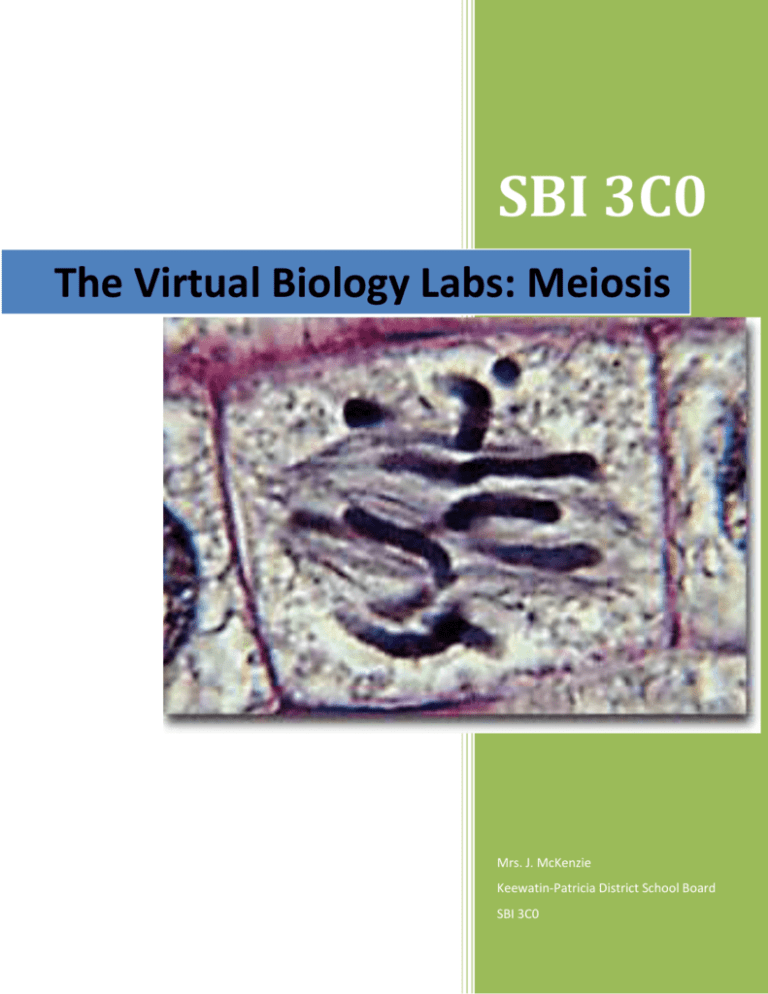
SBI 3C0 The Virtual Biology Labs: Meiosis Mrs. J. McKenzie Keewatin-Patricia District School Board SBI 3C0 Meiosis Lab Objectives: The objectives of this lab are as follows: 1. To review the structure of a chromosome. 2. To study the events associated with meiosis. 3. To apply this knowledge to human genetics by analyzing a karyotype. Introduction: Meiosis is the second important kind of nuclear division. It resembles mitosis in many ways but the consequences of meiotic divisions are very different from those of mitotic divisions. While mitotic division may occur in almost any living cell of an organism, meiosis occurs only in special cells. In animals, meiosis is restricted to cells that form gametes (eggs and sperm). Each species has a characteristic number of chromosomes per somatic cell. Fruit flies have 8; normal humans have 46. They exist as homologous pairs (partners) that are similar in size and shape and carry the same kinds of genes. Thus humans have 23 homologous pairs. The full complement of 46 chromosomes is referred to as the diploid number (referring to the fact that each kind of chromosome is represented twice). In higher organisms when an egg is fertilized the egg and sperm fuse to form a single cell called a zygote which develops into a new organism. If the egg and sperm were both diploid (46 chromosomes each in the case of humans) then the resulting zygote would be tetraploid. This would be an intolerable situation, so a mechanism has evolved to insure that each gamete (egg or sperm) contains only one representative of each homologous pair (or half the diploid number). This is referred to as the haploid number. Haploid Egg + Haploid Sperm = Diploid Zygote The mechanism that makes this possible is meiosis. Meiosis consists of two divisions, Meiosis I and Meiosis II, and can potentially result in the production of four cells. However the DNA is only synthesized once (prior to Meiosis I). The subdivisions of meiosis are named like the subdivisions of mitosis (prophase, metaphase, anaphase, telophase) but as we shall see the events are somewhat different. Meiosis Part I: Lets review the stages of Meiosis. 1. Study the diagrammatic summary of cell division in Meiosis I and Meiosis II in your textbook before you begin. Part II: You are now ready to find the actual stages of meiosis, using the lily anther. The lily flower has six anthers surrounding one carpel. Each anther has two pair of microsporangia ("pollen sacs"). It is in these microsporangia that you will observe the stages of meiosis. REMEMBER: These slides are thin two-dimensional sections through three-dimensional reality. Therefore, you will have to look at several different cells in each microsporangium to see exactly what is going on. Luckily, in the early stages of meiosis, all the cells in the sac are in the same stage. Meiosis in the anther starts with the diploid microsporocyte. Each nucleus has a diploid number of duplicated chromosomes. These cells are still attached in the microsporangium. We will now begin to identify the different stages of meiosis. The cross-section of the lily anther to the left is in the early stages of meiosis. Click on one of the microsporangia to magnify the image of that area and then identify the stage of meiosis the cells are in. Are the cells in: 1. Early prophase I 2. Late prophase I 3. Metaphase I 4. Anaphase I 5. Telophase I 6. Interkinesis In Meiosis II, all the cells in a microsporangium are not in the same stage of division. Therefore, images of single cells have been taken for identification of these stages. Click on the cell and then identify its stage of division. Look for: 1. Prophase II 2. Metaphase II 3. Anaphase II 4. Telophase II 5. Cytokinesis II Cell #s ______________________ Cell #s ______________________ Cell #s ______________________ Cell #s ______________________ Cell #s ______________________ Part III: You finally graduated top of your class and have taken a position as a cytogeneticist. Your job is to construct the karyotypes of your patients in order to look for possible chromosomal abnormalities. Each karyotype has been started for you. The first 12 chromosomes have been matched. Your job is to match the remaining 11 chromosomes, determine whether or not your patient has a chromosomal abnormality and if so, which one, and to diagnose the patient with the expected symptoms of their karyotype. You better get started, your patient list is growing..... Case 1: Case 2: Case 3: Case 4: ______________________________________ ______________________________________ ______________________________________ ______________________________________ Case 5: Case 6: Case 7: Case 8: ______________________________________ ______________________________________ ______________________________________ ______________________________________ Now that you have correctly determined each of the above karyotypes, it is essential to understand how they occur. The abnormalities viewed above are mostly cases of trisomies. Trisomy occurs during meiosis when nondisjunction occurs. Nondisjunction is a failure of chromosome or chromatid to separate to opposite poles during nuclear division. When nondisjunction occurs, two chromosomes or chromatid go to one pole and none go to the other. Two homologous pairs of chromosomes are present within the cell depicted below. The large chromosomes are homologous and the small chromosomes are homologous. The red chromosomes represent maternal genes and blue chromosomes represent paternal genes. Depending on which gamete meets which gamete, three scenarios are possible. The gamete with the extra chromosome could meet a normal chromosome. In this case the patient would have a trisomy in their karyotype, as seen in the previous case studies (i.e. Down's syndrome). The gamete missing a chromosome could meet a normal gamete. The result of this match would be a patient with a monosomy (i.e. Turners syndrome). A normal gamete may also meet a normal gamete in which the patient would be a normal male or female. The following illustrate these scenarios. You have now completed the meiosis laboratory. http://bio.rutgers.edu/~gb101/lab10_meiosis/meiosis_web/index10.html




